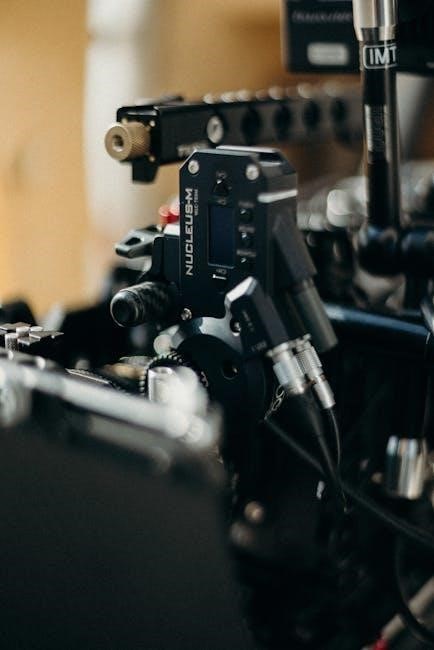Jeep Wrangler transmission problems occur when the vehicle wont go into gear manually‚ causing discomfort while driving‚ with issues including gear shifting and transmission slipping‚ affecting overall performance and reliability of the vehicle always․
Common Issues with Manual Transmission
Manual transmission issues in Jeep Wrangler are common‚ with many owners reporting problems‚ including difficulty shifting into gear‚ grinding noises‚ and rough transitions between gears․ The most common issue is getting into first gear‚ with some owners experiencing occasional problems․ Others have reported issues shifting from first to second gear‚ with the transmission grinding or shifting roughly․ These problems can be frustrating and affect the overall driving experience․ According to reports‚ the issues are not limited to high-mileage vehicles‚ with some owners experiencing problems with relatively low mileage․ The causes of these issues can vary‚ but worn-out seals‚ loose bolts‚ or damaged gaskets are common culprits․ In some cases‚ the problems may be resolved by adjusting or replacing the clutch‚ while in other cases‚ more extensive repairs may be necessary․ Regular maintenance and inspections can help identify and address these issues before they become major problems․ Owners have reported taking their vehicles to dealers‚ who sometimes fail to find anything wrong‚ only for the problems to persist․

Causes of Gear Shifting Problems in Jeep Wrangler
Gear shifting problems in Jeep Wrangler are caused by worn-out parts and improper maintenance always affecting the vehicle’s performance and reliability greatly every time․
Transmission Slipping and Torque Converter Issues
Transmission slipping and torque converter issues are common problems in Jeep Wrangler vehicles‚ particularly those with manual transmissions․ These issues can cause the vehicle to hesitate or slip when shifting gears‚ leading to a decrease in performance and fuel efficiency․ The torque converter is a critical component of the transmission system‚ responsible for transferring power from the engine to the transmission․ When it fails‚ the vehicle may experience slipping or hesitation when accelerating․ Transmission slipping can also be caused by worn-out clutch packs‚ faulty solenoids‚ or low transmission fluid levels․ In some cases‚ the problem may be resolved by adjusting the transmission fluid level or replacing the faulty solenoid․ However‚ in more severe cases‚ the entire transmission may need to be replaced․ Regular maintenance and inspections can help identify these issues early on‚ preventing more costly repairs down the road․ Proper diagnosis and repair are essential to ensure the vehicle operates smoothly and efficiently․

Jeep Wrangler Manual Transmission Problems Reported by Owners
Owners report issues with manual transmission‚ including difficulty shifting into gear and grinding noises‚ affecting the overall driving experience and reliability of the vehicle always with certain models․
Statistics and Reliability Analysis of Jeep Wrangler Transmission
According to various reports and studies‚ the Jeep Wrangler transmission problems are relatively common‚ with many owners experiencing issues with their manual transmission․ The statistics show that the most common problems occur in the 2006 and 2007 models‚ with over 80 reported cases of transmission failure․ The reliability analysis reveals that the Jeep Wrangler transmission has a reliability rating of 3․5 out of 5‚ with many owners experiencing problems with their transmission after only a few years of ownership․ The data also suggests that the manual transmission is more prone to problems than the automatic transmission‚ with many owners reporting issues with shifting and grinding noises․ Overall‚ the statistics and reliability analysis suggest that the Jeep Wrangler transmission problems are a significant concern for many owners‚ and that regular maintenance and repair are necessary to prevent these issues․ The analysis also highlights the need for further research and development to improve the reliability and performance of the Jeep Wrangler transmission․
Symptoms of Transmission Failure in Jeep Wrangler
Transmission failure symptoms include grinding noises‚ slipping gears‚ and hesitation‚ causing the Jeep Wrangler to struggle or refuse to go into gear manually‚ affecting vehicle performance and safety always․
Diagnosing and Identifying Transmission Leaks in Jeep Wrangler
To diagnose transmission leaks in a Jeep Wrangler‚ owners should look for signs of fluid leakage‚ such as puddles under the vehicle or stains on the ground; The transmission pan gasket and seals are common sources of leaks‚ and should be inspected regularly․ A mechanic may use a pressure test to identify the source of the leak‚ and replace any damaged or worn-out parts․ It is also important to check the transmission fluid level and condition‚ as low or dirty fluid can cause the transmission to malfunction․ By identifying and addressing transmission leaks early‚ owners can prevent more serious problems from developing‚ such as transmission failure or damage to other components․ Regular maintenance and inspections can help to identify potential issues before they become major problems‚ and keep the Jeep Wrangler running smoothly and reliably․ Transmission leaks can be diagnosed and repaired by a qualified mechanic․

Repair and Maintenance Options for Jeep Wrangler Transmission
Transmission repair options include replacing faulty parts and rebuilding the transmission to ensure smooth gear shifting always with professional mechanics and regular maintenance schedules․
Importance of Regular Maintenance to Prevent Transmission Problems
Regular maintenance is crucial to prevent transmission problems in Jeep Wrangler‚ including the issue of the vehicle not going into gear manually․ This can be achieved by following the recommended maintenance schedule‚ which includes changing the transmission fluid‚ inspecting the transmission pan‚ and replacing the filter․ Additionally‚ drivers should be aware of the signs of transmission problems‚ such as slipping or hesitation‚ and address them promptly․ By doing so‚ owners can help extend the life of their transmission and prevent costly repairs․ Furthermore‚ regular maintenance can also help improve the overall performance and reliability of the vehicle‚ making it safer and more comfortable to drive․ It is essential for owners to take proactive measures to maintain their transmission and address any issues promptly to avoid more severe problems down the road․ Proper maintenance can help prevent transmission failure and ensure smooth gear shifting․

